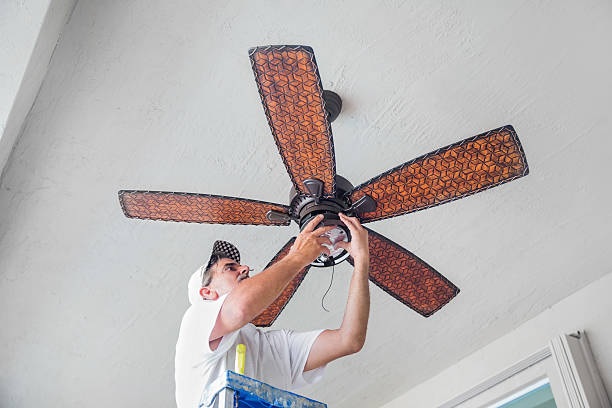Ceiling fans had been a staple in homes for many years, imparting now not most effective purposeful cooling however additionally a touch of aesthetic enchantment.
Whether it’s the gentle whirring on a summertime day or the diffused breeze in a cozy living room, ceiling fanatics enhance consolation and fashion.
In this guide, we delve into the arena of ceiling fan installations and maintenance, exploring the key issues, DIY pointers, and the significance of professional assistance.
Choosing the Right Ceiling Fan
Explore the possibilities of cooler, more comfortable home Ceiling Fan Installations and Repair solutions. We invite you to embark on a journey where the gentle whirr of a perfectly balanced fan transforms your spaces into havens of tranquility and style.
Sizing Matters: Selecting the Appropriate Fan Size
Before diving into the installation process, it’s critical to pick a ceiling fan that complements the room’s size.
Larger rooms normally require lovers with longer blades to circulate air successfully, while smaller rooms gain from more compact fan designs. Understanding the connection between fan length and room dimensions ensures the most useful performance.
Style and Functionality: Matching Your Décor
Ceiling fans are available in a myriad of patterns, from traditional to modern-day, rustic to trendy. Selecting a fan that aligns together with your interior décor complements each form and function.
Consider elements including blade design, end, and the presence of integrated lighting to gain a cohesive appearance that elevates your area.
DIY Ceiling Fan Installation: A Step-by means of-Step Guide
Pre-Installation Preparations
Before beginning the installation, it is crucial to turn off the electricity to a certain circuit. Using a voltage tester can provide an extra layer of protection guarantee.
Additionally, gather all necessary equipment and additives, ensuring a clean setup technique.
Mounting the Fan Bracket
The fan bracket serves as the anchor point for the entire ceiling fan. Carefully comply with the producer’s instructions to secure the bracket to the ceiling, ensuring balance. This step lays the inspiration for the fan’s stable attachment.
Wiring Connections: Ensuring Safety
Proper wiring is paramount to a safe and functional ceiling fan. Connect the fan’s wires to the corresponding wires within the ceiling, generally shade-coded for comfort.
Secure connections tightly and use twine nuts to ensure a dependable electric connection.
Attaching Fan Blades and Light Kit
With the fan securely hooked up, attach the fan blades in keeping with the manufacturer’s instructions. If your fan consists of a light kit, that is the opportune time to hitch it.
Take care to stabilize the blades to save you from wobbling at some stage in operation.
Testing and Fine-Tuning
Before finalizing the installation, test the fan at various speeds and verify that the blades rotate easily with no wobbling or unusual noises.
Use the covered far-off manage or wall transfer to assess the fan’s functionality very well.
Common Ceiling Fan Issues: DIY Troubleshooting
Wobbling Woes: Balancing Your Fan
Wobbling is a common issue that could arise from unevenly aligned fan blades. DIY enthusiasts can use a fan-balancing kit.
Which commonly consists of clip-on weights, to cope with this trouble. Ensuring that blades are aligned and weights are disbursed calmly can restore balance.
Unresponsive Remote Control
If your ceiling fan comes with a faraway manager and fails to reply, test the batteries first. If the batteries are functional, look into the remote’s circuitry for free connections.
Alternatively, remember to reprogram the far-flung consistent with the producer’s commands.
Noisy Operation: Addressing Unwanted Sounds
A noisy ceiling fan can disrupt the tranquility of a room. Common assets of noise encompass free screws, misaligned blades, or problems with the motor.
Conduct a radical inspection, tightening any loose additives and ensuring that blades are securely attached.
When to Seek Professional Ceiling Fan Repair Services
Electrical Issues and Wiring Complexity
While many ceiling fan problems may be resolved via DIY efforts, electrical problems frequently require expert information.
If you stumble upon complex wiring troubles, it is beneficial to seek the help of a certified electrician to ensure safety and compliance with electric codes.
Motor Malfunctions
Ceiling fan automobiles are complex components that could require specialized understanding for repair.
If your fan’s motor is malfunctioning, making uncommon noises, or operating irregularly, consulting an expert technician can assist in diagnosing and coping with the difficulty successfully.
Ceiling Fan Upgrades: Modern Features and Energy Efficiency
Smart Fan Integration
Modern ceiling fans regularly include clever features, permitting integration with domestic automation systems or manipulation through cell apps.
Upgrading to a clever ceiling fan can beautify comfort and strength efficiency, imparting superior functionalities together with scheduling and far-flung control.
Energy-efficient lighting Options
Consider upgrading your ceiling fan’s lighting fixtures to strength-efficient LED bulbs. Not simplest do those bulbs consume much less power.
In addition, they also have a longer lifespan, lowering the frequency of replacements. This simple upgrade contributes to each fee’s financial savings and environmental sustainability.

Conclusion
Ceiling fanatics are extra than useful home equipment; they may be design factors that contribute to the general atmosphere of a room.
Whether you embark on a DIY setup adventure or are looking for professional repair services, the goal is obvious to harness the breeze and revitalize your surrounding areas.
With the proper preference, right setup, and well-timed repairs, your ceiling fan becomes a beacon of cool consolation and fashion, improving the harmony of your own home.
